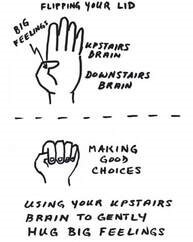Hugging Big Emotions
Hugging Big Emotions
From time to time, all of us experience what we might call ‘big emotions’. As we mature, we are more adept at identifying and recognising how these feelings may occur and how we might deal with them. However, this is a gradual process and for younger children it can be a challenge when these big emotions appear.
In assemblies over the past few weeks, I have been speaking about how to recognise these emotions and how the brain processes different situations. Perhaps the easiest way to explain this is by using the analogy of an upstairs and downstairs brain.
 The downstairs brain includes lower regions of the brain that are responsible for basic functions (like breathing and blinking) as well as impulses and emotions (like anger and fear). The upstairs brain is responsible for more intricate mental processes like planning, decision-making, self-awareness, empathy and morality. When a child’s upstairs brain is functioning well, they are more likely to be able to slow down, think before they act, regulate emotions, self-soothe and consider others’ feelings and perspectives – all important areas of healthy human functioning.
The downstairs brain includes lower regions of the brain that are responsible for basic functions (like breathing and blinking) as well as impulses and emotions (like anger and fear). The upstairs brain is responsible for more intricate mental processes like planning, decision-making, self-awareness, empathy and morality. When a child’s upstairs brain is functioning well, they are more likely to be able to slow down, think before they act, regulate emotions, self-soothe and consider others’ feelings and perspectives – all important areas of healthy human functioning.
While the downstairs brain, with its strong emotions and impulses, is fully built and functioning in young children, the upstairs brain is unfinished and is still under construction well into a person’s twenties. Our job as adults is to support the integration of the downstairs and upstairs regions of kids’ brains.
 The way we have explained this to our students is by using a clenched fist wrapped around a thumb. When our upstairs brain (fingers) is wrapped safely around our downstairs brain (thumb), we are connected and can recognise the feeling and the impact it is having on us. However, if we ‘flip our lid’, our brains become disconnected and they are unable to talk to each other. Our downstairs brain takes over and makes the decisions based on instinct rather than logic.
The way we have explained this to our students is by using a clenched fist wrapped around a thumb. When our upstairs brain (fingers) is wrapped safely around our downstairs brain (thumb), we are connected and can recognise the feeling and the impact it is having on us. However, if we ‘flip our lid’, our brains become disconnected and they are unable to talk to each other. Our downstairs brain takes over and makes the decisions based on instinct rather than logic.
By showing our students the connection between our ‘two brains’ we have the ability to hug our big emotions and re-engage the logical portion of our brain to bring our emotional thermometer down.
Year 5 Camp
Tuesday morning marked the first of our junior camps for 2020. There was much excitement and some nerves as the students packed the bus bound for Bornhoffen in the Gold Coast Hinterland. In the current environment, it has been especially challenging to make sure that all our plans for the outdoor education experience have met the health regulations set down by the government. We thank Ms Kim Wood for her planning and expertise in making this happen as well as the staff attending Mrs Lu Pollard, Mr Scott Crompton, Mr Scott Massie and Mrs Christine Dobson. We wish them well and look forward to hearing about the experience on their return.
Take care and God bless.
Mr Damian Davis, Head of Staff and Students P-5
